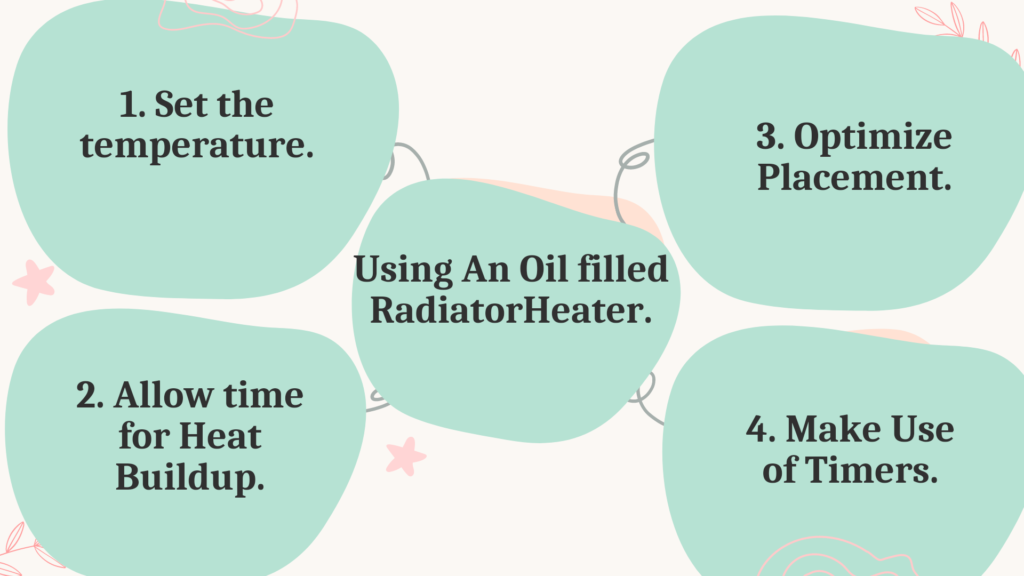Table of Contents
Oil-filled radiator heaters are great for keeping your space toasty in the chillier months. The heater warms up diathermic oil inside, and convection transfers that heat to the air around it. Plug it in, select your desired temperature, and the heating element will start the oil warm-up process.
The advantage of these heaters is that they store heat for long periods of time, even after being turned off. Perfect for when you’re away or when you need overnight warmth.

When using an oil-filled radiator heater, make sure there is enough space around it for proper air circulation. Don’t put any flammable materials near it, and don’t cover it with clothing or other items. Read and follow the manufacturer’s safety instructions too.
If your radiator needs refilling, consult its manual for instructions. Most radiators come pre-filled with diathermic oil and don’t need to be replaced. If you notice reduced performance or any leaks, unplug the heater and let it cool down before adding new oil.
Maintain your heater in top condition with regular cleaning. Use a soft brush or vacuum attachment to get rid of dust build-up on the fins or columns. If you have any technical issues, like a faulty thermostat or power cord, it’s best to call a professional for repairs.
Understanding the Basics of an Oil Filled Radiator Heater
Oil filled radiator heaters are essential for efficient home heating. They use diathermic oil, heated by an electric element, to warm the surroundings. When using one, select the right heat level. Most models have multiple settings. Start low and increase if needed.
Maximize performance by exposing the heater’s surface area and keeping it away from walls and furniture. Oil filled radiator heaters have high thermal mass, so they emit warmth even after being turned off. They’re suitable for long-lasting heat retention, especially at night.
Using an Oil Filled Radiator Heater

Oil-filled radiator heaters are great for efficiently heating up your home. They use diathermic oil to transfer and retain heat, providing warmth in any room. Here’s how to get the most out of it:
- Set the temp: Most come with adjustable temp settings. Use the control panel or thermostat to set the desired level of warmth.
- Allow time for heat buildup: Oil-filled radiators rely on convection. It may take some time to reach max potential, so be patient.
- Optimize placement: Place the radiator in a central location away from walls and furniture. This ensures proper circulation of warm air.
- Make use of timers: Many come with timer functions, which can be programmed to turn on and off. This is great if you want to wake up or return home to a warm environment.
To get the most out of your oil-filled radiator heater, keep in mind these details:
- Heat retention: The diathermic oil acts as a heat reservoir, storing thermal energy even after the unit has been turned off.
Pro Tip: Place a reflective surface behind the heater to direct more heat into the room.
Follow these tips and enjoy cozy warmth during cold winter months with your oil-filled radiator heater!
Maintenance and Repairs
To keep your oil-filled radiator heater in good shape, regular maintenance and repairs are a must. Here are some steps to follow:
- Inspect it for any damage or leaks. Look out for cracks or dents and check the power cord for fraying and exposed wires.
- Clean the surface with a damp cloth, unplugging the unit first. Don’t use abrasive cleaners. Check the fins for any dirt or dust, using a soft brush or vacuum cleaner to remove them.
- Refill the oil if needed. Most come pre-filled but some may require more due to leakage or evaporation. Check the manufacturer’s instructions for refilling your specific model.
- Don’t place objects on the radiator as this can block airflow and reduce heating efficiency. Also, position it away from curtains, furniture, and other flammable items to avoid potential fire hazards.
- Regularly check and tighten any loose screws or bolts on the unit. This will help ensure stability and prevent any safety issues.
- If the performance or noises decrease, it’s time to clean or replace the heating element. Refer to the manufacturer’s guidelines for instructions.
Following these steps will keep your oil-filled radiator heater running efficiently and reliably. Proper maintenance and repairs are the key!
Comparison How To Use An Oil Filled Radiator Heater with Other Types of Heaters
Oil filled radiator heaters stand out from other types of heaters. They have high heat retention and energy efficiency, with low noise levels. Plus, they have unique benefits too.
First, they provide steady and consistent heat from the diathermic oil stored inside. This ensures an even temperature in the room.
Second, the fin surface area allows for efficient heat transfer. This warms up the room quickly.
Finally, regular maintenance keeps it running optimally and long-lasting.
So, if you’re looking for a heater that’ll keep you warm during winter, while making you chuckle, an oil filled radiator heater is the one!
Frequently Asked Questions
1. How do I use an oil filled radiator heater?
To use an oil filled radiator heater, start by finding a suitable location for it in your room. Make sure there is enough space around it for proper airflow. Plug the heater into an electrical outlet and turn it on using the power switch or dial. Adjust the thermostat to set your desired temperature and let the heater warm up. The oil inside the heater will heat up, and the fins on the surface of the heater will distribute the warmth into the room.
2. Do oil filled radiator heaters really work?
Yes, oil filled radiator heaters are an effective method of heating a room. They work by heating diathermic oil contained within the unit, which in turn warms up the metal body of the heater. The large surface area and fins on the radiator help to distribute the heat evenly throughout the room, creating a comfortable environment. These heaters also have good heat retention properties, allowing them to continue radiating warmth even after they have been turned off.
3. How do I refill an oil filled radiator heater?
Oil filled radiator heaters are designed to be maintenance-free, and they do not require refilling. The diathermic oil inside the unit is permanently sealed and should last the lifetime of the heater. If you notice a decrease in heating performance or any other issues, it is recommended to consult the manufacturer’s manual or contact customer service for assistance.
4. Can I repair an oil filled radiator heater myself?
It is generally not recommended to attempt repairs on an oil filled radiator heater yourself. These heaters contain electrical components and may pose a risk if not handled properly. If your heater is not functioning correctly or requires repairs, it is best to contact a professional technician or the manufacturer’s customer service for assistance.
5. Are oil filled radiators safe?
Oil filled radiators are generally considered safe to use as they do not have exposed heating elements or open flames. The hot oil inside the unit is sealed, reducing the risk of burns. However, it is still important to follow safety precautions such as keeping flammable materials away from the heater, not leaving it unattended, and placing it on a stable surface. Additionally, it is advised to check for any safety certifications or standards when purchasing an oil filled radiator heater.
6. Do oil filled radiator heaters use a lot of electricity?
Compared to other types of electrical heaters, oil filled radiator heaters tend to be more energy efficient. Once the oil is heated, the heater uses minimal electricity to maintain the desired temperature. The amount of electricity used will depend on factors such as the size of the heater, the temperature settings, and the duration of use. Generally, oil filled radiators are considered a cost-effective heating solution for small to medium-sized rooms.
Conclusion
Cozy up your home with an oil-filled radiator heater! It’s reliable and efficient. The unit works by heating oil, which then radiates heat. Plus, it’s easy to use and requires little maintenance.
Simply plug in the device, select your desired temperature, and wait for it to warm up. It’ll maintain that level of warmth for hours. The oil inside acts as a heat reservoir, so the room stays cozy even after the heater’s turned off.
When it comes to refilling or repairing your oil-filled radiator heater, follow the manufacturer’s instructions. Refill with diathermic oil, found at most hardware stores. If repairs are needed, it’s best to get professional help.
Invest in an oil-filled radiator heater to enjoy long-lasting warmth without skyrocketing electricity bills. Stay snuggly with these efficient devices today!
References:
